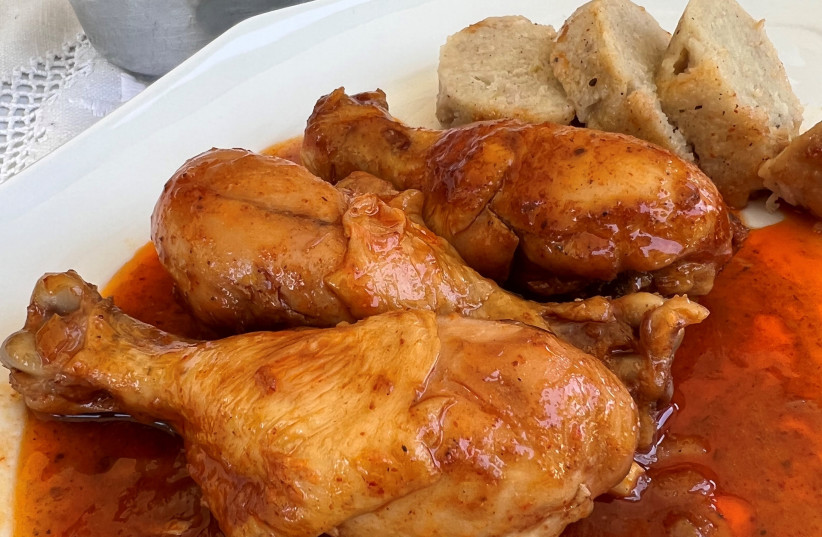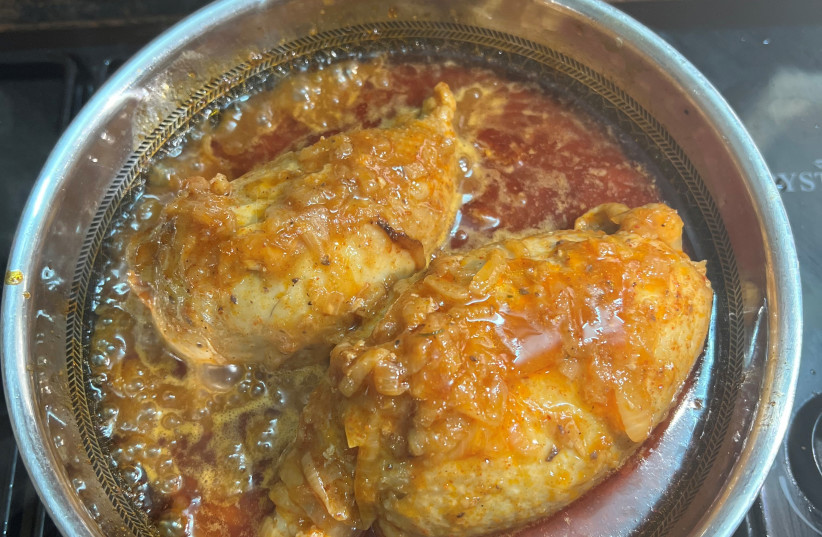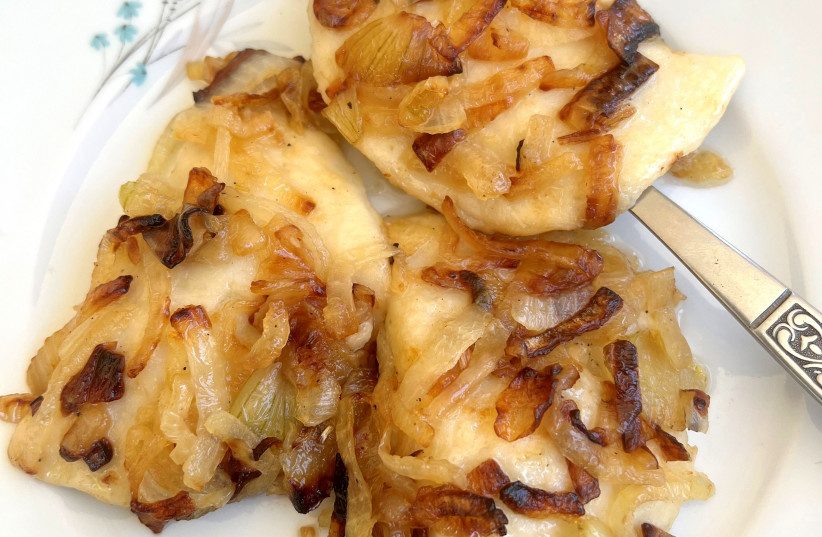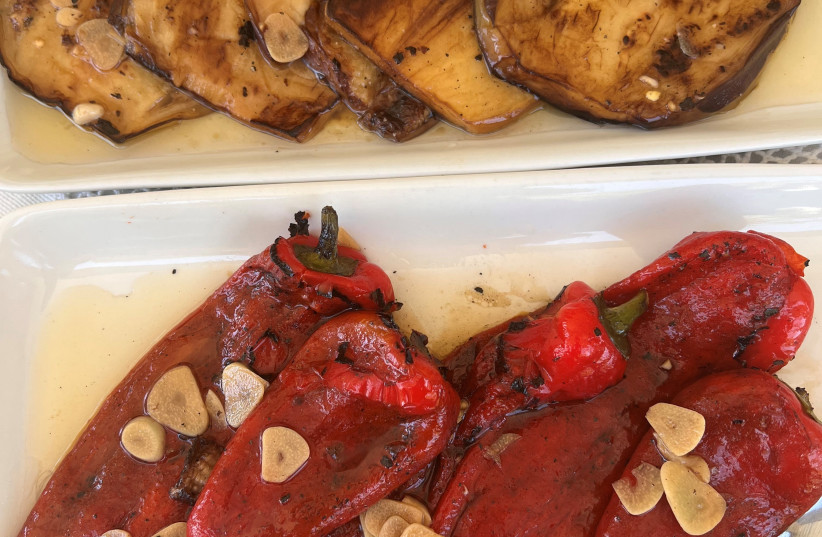My favorite season is quickly approaching. There’s something in the air when we get close to the Jewish New Year that feels so special to me. I open the window in my study, and I can smell the guava fruits ripening on the tree in my garden. And every year at this time, the branches of our pomegranate trees are so heavy with ripe fruit that they seem to be at the breaking point.
To my mind, the pomegranate is one of the most royal of fruits, since it grows its own crown. Every year, I watch diligently as the tiny fruits begin to bud and develop into small green beads. As they grow larger, their color slowly changes to yellow, and then finally turns bright red as they ripen fully. You never know if the seeds from the pomegranates will be as sweet as honey or a bit sour.
We have two pomegranate trees in our backyard. One of them produces large, beautiful fruit, while the fruits on the other one are more modest. And yet, for some reason, the seeds from the tree with the smaller pomegranates taste sweeter. And so I use the larger, royal-looking fruits to place whole in the center of the table on Rosh Hashanah, and I use the seeds from the smaller ones in many of the dishes I serve.
Unfortunately, I do not have a quince tree in my yard, so that means that I’ve added them to the list of items I will purchase at my favorite market in preparation for cooking the festive Rosh Hashanah meals. I love walking along the fruit stalls and picking out quince and a variety of apples, which I will use to make the traditional compote for the holiday meal.
When I was growing up, each holiday had its own traditional menu. These grand meals involved preparing recipes that had been passed down from one generation to the next. Preparing these dishes required a great deal of skill and knowledge, and there always seemed to be a grandmother or aunt around who was busy supervising and teaching the younger generation.

Nowadays, people love learning about new food cultures and adding to their repertoire recipes they might never have heard about, were it not for that cooking workshop they’d joined or the recipe they saw online.
In preparation for the Jewish New Year, I reached out to Golan Israeli, the executive chef at the Dan Accadia Hotel Herzliya, and asked if he could recommend a few special dishes for the festive Rosh Hashanah meal. He invited me to join him in his kitchen at the hotel so I could watch him as he prepared for the upcoming holiday meals.
Golan, who is married and has two children, loves cooking. He began his career immediately upon completing his IDF service, and at 28 was hired as a chef at a five-star Tel Aviv hotel. He was the youngest chef ever to achieve that feat.
Golan is constantly developing new and innovative dishes and changing up old ones in an effort to provide tasty meals that are also healthy.
“I am always thrilled when people enjoy the food I prepare for them,” Golan exclaims. “I use this gift that I have been given to make people happy. Believe, me, Pascale, I do not take this talent for granted. I pour my heart and soul into the food I prepare. This is the way I was taught, and I hope to be able to pass it down to the next generation. For that reason, it is extremely important to me to take the time and patiently teach young chefs who work with me at the hotel how to work together as a team.
“For me, being a chef requires a huge investment, and you can expect to get lots of cuts and burns. Unlike what many people see on reality TV shows, cooking is an art. Just as a painter will use different colors on a canvas, so, too, do chefs use interesting and exotic ingredients in order to create delicious and aesthetically pleasing dishes.”
“For me, being a chef requires a huge investment, and you can expect to get lots of cuts and burns. Unlike what many people see on reality TV shows, cooking is an art. Just as a painter will use different colors on a canvas, so, too, do chefs use interesting and exotic ingredients in order to create delicious and aesthetically pleasing dishes.”
Golan Israeli
Golan says that his love for cooking reaches back to time he spent in his early years in the kitchen with his mother, Varda, now 78, an autodidact, who learned to prepare dishes hailing from Romanian and Polish cuisine from her elders.
I asked Golan if he’d be willing to join his mother in her kitchen in Kfar Hess, so that together they could prepare a few of his favorite dishes from childhood. As they cooked, she guided him and explained various techniques and shortcuts she’d learned from her Eastern European elders.
Below, you will find an assortment of recipes that Golan and Varda have compiled to create the ultimate menu for the upcoming Rosh Hashanah meal. The first recipe is for Varda’s favorite honey-sweetened chicken. The second recipe is for helzel, which is chicken neck stuffed with potato. The third is for kreplach, filled with potato. Fourth is a recipe for Romanian eggplant salad, and then lastly, quince (or apple) compote.
May each and every one of you have a sweet new year.
Shana tova!

Varda’s brown chicken
Makes 10 servings.
- 5 Tbsp. olive oil
- 2 large onions, sliced
- 10 chicken leg quarters
- 7 garlic cloves, sliced
- 4 Tbsp. paprika
- 1 tsp. spicy paprika
- 1 Tbsp. chicken or beef soup powder
- 3 Tbsp. honey
- 1 tsp. salt
- ½ tsp. black pepper
- Juice from 1 orange (1 cup)
- 1.5 liters water (or just enough to cover chicken)
Heat the oil in a 40-centimeter-diameter pot (even better if it has a double bottom). Sauté the onion slices, then add the chicken pieces, with the skin side facing down.
Sauté the chicken pieces for a few minutes until they begin to brown, then flip them over and sauté the other side. Throughout, keep moving the onion slices around so they don’t burn. Add the garlic and spices and mix gently.
Pour the orange juice on top and mix, making sure to lift up any pieces that have stuck to the bottom of the pot. Add the water just until it covers the chicken. Shake the pot gently so that the sauce covers the chicken pieces.
Bring the pot to a boil, then lower the heat as much as possible. Simmer for 90 minutes until the sauce has thickened. When the chicken is about halfway cooked, flip over the chicken pieces.
When the chicken has cooked for about an hour, you can add the helzel (see recipe below). Continue cooking another 30 minutes with the helzel.
Level of difficulty: Medium
Time: 2 hours
Status: Meat

Helzel (stuffed chicken neck)
Makes 10 servings.
- 2 large onions
- 3 Tbsp. olive oil
- 5 white potatoes
- Salt and pepper, to taste
- 1 cup wheat flour or semolina
- 5 chicken necks
Heat the oil in a frying pan. Chop the onions, then sauté them until they begin to brown.
Peel the potatoes, then grate them thinly into a large bowl. Add the sautéed onion, salt and pepper to the potatoes. Add the flour and mix well.
Sew up the side and bottom of the chicken neck skin so that it’s like an empty tube, with the top still open. Prepare the other four skins in the same way. Fill the necks with the potato mixture, then sew the tops closed, too. Don’t push the mixture in too densely; otherwise, the skin will break open during cooking.
Fill up a pot of water and add half a teaspoon of salt and bring to a boil. Add the stuffed chicken necks to the pot and cook for 10 minutes. Remove them from the water and add them to the pan with the chicken quarters (see recipe above) and continue cooking another 30 minutes. Serve hot.
Level of difficulty: Medium-difficult
Time: 1.5 hours
Status: Meat

Potato kreplach (dumplings)
Makes 30 pieces.
Dough:
- 500 gr. flour, sifted
- 1.5 cups boiling water
- 1 egg
- ¼ cup oil
- ½ tsp. salt
Filling:
- 5 white potatoes
- 1 tsp. kosher salt
- 4 large onions, sliced
- Salt and pepper, to taste
- 5 Tbsp. olive oil
For frying:
- 5 Tbsp. olive oil
- 2 onions, sliced
Cut the potatoes into large chunks and cook them in water with one teaspoon of kosher salt for 30 minutes until they’ve completely softened.
In a separate pan, heat the olive oil and sauté the onions until they’ve browned. Turn off the heat and add the softened potatoes. Mash the onions and potatoes with a fork. Season with salt and pepper. Taste, and adjust seasoning. Let cool completely.
Add all the dough ingredients to a large bowl and knead well.
Roll out the dough on a floured work surface until it’s ½ cm. thick. Use a glass to cut out circles with an 8-centimeter diameter. Place a spoonful of potato mixture in the middle of the circle, and then close the dough around the filling by lifting up one side and pressing the dough closed, forming a half-moon shape. Seal well with your fingers so none of the mixture can escape.
Fill a large pot with water. Add 1 teaspoon of salt and bring to a boil. Add the kreplach and cook them until they rise to the top of the water. Remove them and place them in a bowl.
Arrange the kreplach on a serving plate, and then add the fried onions on top. Serve hot.
Level of difficulty: Medium
Time: 45 minutes
Status: Parve

Romanian eggplant
Makes 10 servings.
- 2 eggplants, low weight (those with fewer seeds)
- 100 gr. kosher salt
- 1 liter oil (canola, sunflower or soybean)
- 5 bell peppers or 10 Chervena chushka (shoshka) peppers
Marinade:
- ½ liter oil
- ½ liter vinegar 5%
- 10 cloves of garlic, crushed
- 1 tsp. salt
- ½ tsp. black pepper
Peel and slice the eggplant lengthwise into 1-centimeter-thick pieces. Arrange them on a tray and sprinkle kosher salt on them. Let them rest for 1 hour.
Add all the marinade ingredients to a bowl and whisk them together. Pour into a large container that has an airtight seal.
Heat oil for deep-frying in a pan and fry the eggplant slices until they’ve turned golden brown. Add the hot eggplant slices to the bowl with the marinade.
Roast the peppers over an open flame, then place them in a pot and cover immediately. Alternatively, place the roasted peppers in a plastic bag and seal it well. Let the peppers cool for about 10 minutes, then remove the burnt skin. Cut off the top of the peppers, and remove the pith and seeds. Then, add the peppers to the marinade alongside the eggplant slices.
Level of difficulty: Easy
Time: 1.5 hours
Status: Parve
<br>Quince or apple compote
Makes 10 servings.
- 5 quinces or Hermon apples
- 3 Tbsp. sugar
- 1 cinnamon stick
- Water, to cover
- Juice from ½ a lemon
- 100 gr. light raisins
Peel the quinces or apples and cut into eights. Place the fruit pieces in a medium pot and add the sugar, cinnamon and water, to cover. Stir the mixture, and then add the lemon juice. Bring to a boil, then lower the heat and cook for 1 hour.
Store the compote in the fridge until serving time.
Note: If you’re using apples, you can add 1 cup of plums to the mixture and add a few minutes to the cooking time.
Level of difficulty: Easy
Time: 1 hour
Status: Parve
Translated by Hannah Hochner.
